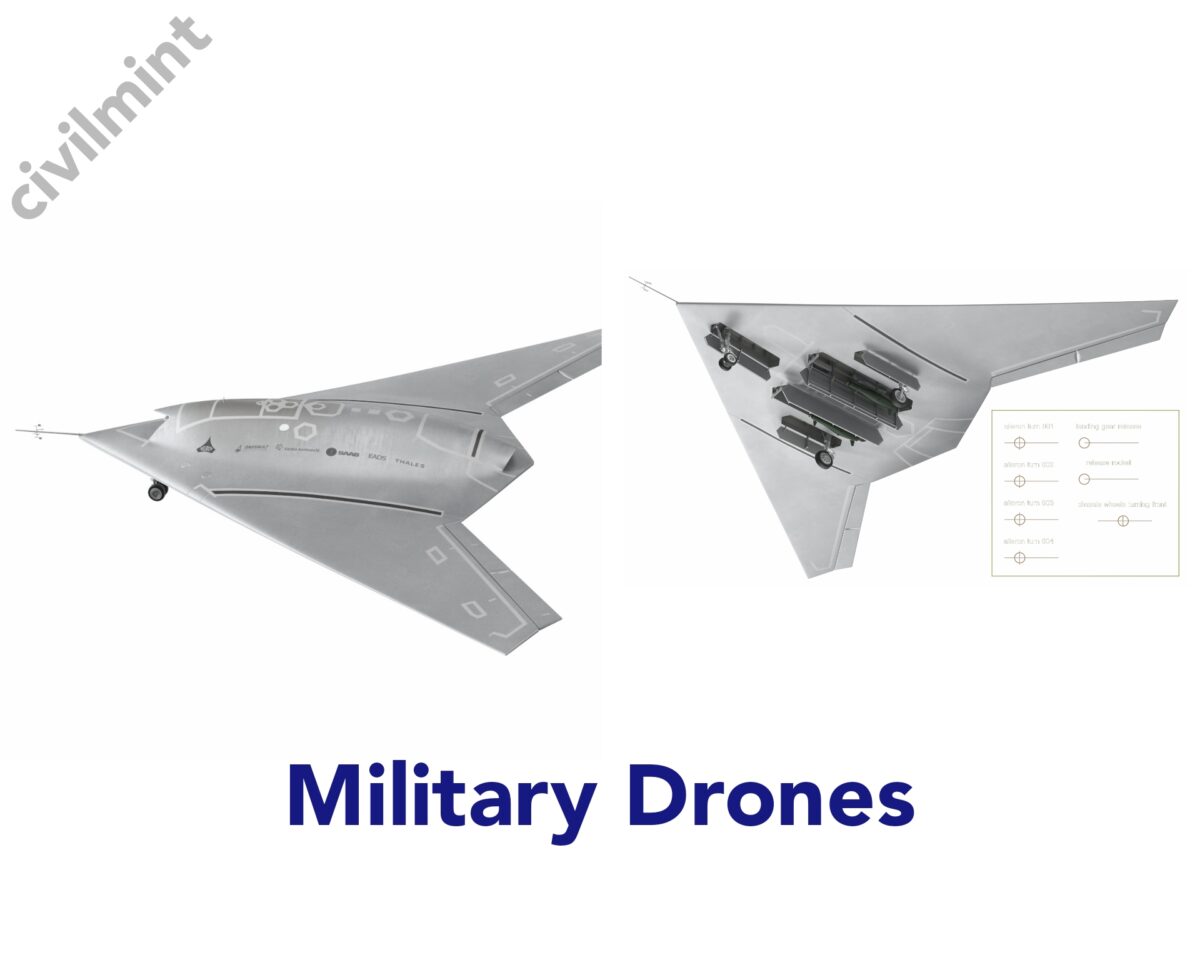Table of Contents
Introduction
Military drones serve as indispensable tools for security units, facilitating complex and discreet surveillance missions while reducing the inherent risks associated with human involvement. Autonomously operated and remotely controlled through sophisticated Ground Control Units (GCS), these unmanned aerial vehicles (UAVs) play a vital role in modern security operations. Distinguishing military drones from their commercial counterparts are a set of essential characteristics: unwavering reliability, extended endurance flight time of more than 60 minutes, covert and stealthy operations, and integration into a comprehensive system that includes ground control units and unobstructed areas for deployment. Includes designated carrying units. Additionally, military drones prioritize data security through encryption, demonstrate resilience against GPS and communications jamming, and boast the ability to navigate challenging terrain, in contrast to the more straightforward deployment processes of commercial drones.

The essence of stealth becomes paramount in the field of military drones, incorporating auditory subtleties beyond mere visual discretion. Reduction in size and camouflage have been mandated to achieve visual stealth, blending seamlessly with the colors of the sky, including all components such as the payload and propeller. In contrast, noise theft remains a complex challenge with limited empirical data, requiring extensive trial and error. Propellers rotating in the air produce noise, the noise level is directly related to the speed of the motor. Therefore, complex optimization of power efficiency is required to achieve noise stealth. In short, military drones adopt cutting-edge technology and stringent requirements, ensuring that they remain at the forefront of covert and effective security operations, ready to protect national interests and lives without compromise.
Importance Of Military Drones
Drones offer real-time aerial surveillance, allowing the military to gather valuable information, monitor enemy movements, and assess the battlefield without risking human lives.
Armed drones can precisely strike enemy targets with less collateral damage. They provide a cost-effective and low-risk way to engage hostile forces.
Drones enhance the capabilities of traditional military assets like fighter jets and ground troops by giving extra eyes in the sky and the ability to hit targets from a distance.
Drones can stay over a specific area for a long time, offering continuous monitoring and support, which is vital in counterterrorism and border security.
They can also be used for logistics, delivering supplies to remote or hard-to-reach places, including medical aid in humanitarian missions.
Using drones reduces the risk to military personnel, as they can carry out missions remotely, lowering casualties and protecting soldiers’ lives.
Compared to manned aircraft, drones are often more cost-effective to use, maintain, and replace, making them a practical choice for defense budgets.
Drones come in various sizes and configurations, making them adaptable to many military missions, from reconnaissance to combat.
Drones can be rapidly deployed in crisis situations, providing timely information and the ability to strike targets quickly.
Types Of Military Drones
Single-Rotor Drones are agile rotary-wing aircraft featuring a single, large rotor akin to traditional helicopters. They excel in tasks requiring precision and stability, with the unique ability to hover in place. Military applications commonly employ these drones for reconnaissance, surveillance, cargo transport, and even armed missions due to their adaptability. However, they demand a higher degree of operational and maintenance complexity compared to other drone types.
Fixed-Wing Drones closely resemble traditional airplanes with fixed wings, known for their remarkable speed, efficiency, and extended flight endurance in comparison to rotorcraft. They find utility in military scenarios requiring long-range reconnaissance, surveillance, and target tracking. Their limitation lies in the need for runways or catapults for takeoff and landing, restricting their operational versatility in confined or remote areas.
Multi-Rotor Drones are compact, highly maneuverable aerial vehicles fitted with multiple rotors, often arranged in a quadcopter or hexacopter configuration. Their agile nature and ability to hover make them ideal for close-range reconnaissance, surveillance, and urban warfare missions. These drones are preferred when stealth and compactness are crucial, although their flight duration is typically shorter than fixed-wing alternatives.
Fixed-Wing Hybrid VTOL (Vertical Takeoff and Landing) Drones combine the advantages of both fixed-wing and VTOL capabilities. They can vertically take off and land, similar to multi-rotor drones, but transition to fixed-wing flight once airborne, offering increased speed and endurance. These versatile drones are employed in missions requiring long-distance coverage while maintaining the flexibility of vertical takeoff and landing, including reconnaissance, surveillance, cargo delivery, and extended-range operations.
Payload Capacity Of Military Drones
The payload capacity of military drones can vary widely depending on the specific model and its intended mission. Some smaller reconnaissance drones may have payload capacities of just a few kilograms, while larger armed drones can carry payloads in excess of 1,000 kilograms (1 ton) or more. It’s important to note that military drone technology is continually evolving, so specific payload capacities may change over time as new models are developed and deployed.
- MQ-9 Reaper: The MQ-9 Reaper, a widely known armed drone, has a payload capacity of approximately 1,700 kilograms (3,750 pounds). It can carry a variety of munitions, including Hellfire missiles and precision-guided bombs.
- RQ-4 Global Hawk: The RQ-4 Global Hawk, a high-altitude reconnaissance drone, can carry payloads of up to 1,360 kilograms (3,000 pounds). Its primary mission is surveillance and intelligence gathering.
- Predator XP: This is another popular drone, and it has a payload capacity of around 204 kilograms (450 pounds). It’s often used for surveillance and reconnaissance tasks.
- MQ-1C Gray Eagle: The MQ-1C Gray Eagle drone has a payload capacity of approximately 225 kilograms (500 pounds). It’s often used for reconnaissance, surveillance, and close air support.
- CH-4 Rainbow: The CH-4 Rainbow drone, developed by China, has a payload capacity of around 345 kilograms (760 pounds). It’s used for reconnaissance and combat missions.
Read also: Working Principle Of Drone
Conclusion
Military drones are a vital asset in modern warfare, providing the versatility and adaptability to meet the demands of various missions while ensuring the safety of military personnel. As technology advances, these unmanned aircraft will play an even more important role in protecting nations and combating emerging threats.
